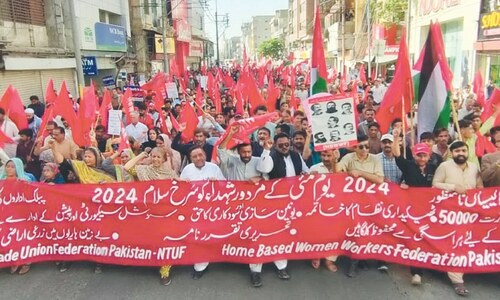KARACHI: Two interesting talks on the history and architectural legacy of Karachi rounded off the four-day cultural heritage programme at the Alliance Francaise on Monday evening.
Farooq Soomro, founder of the Karachi Walla, was the first speaker of the evening. He kept his presentation short and simple and didn’t speak as much as one would have liked him to. In fact, by the time some men and women interested in listening to the speakers entered the conference hall of the cultural centre, his talk had ended.
Mr Soomro divided his presentation into two parts: the first one was to do with his experiences of visiting old Karachi neighbourhoods, primarily the Saddar region; and the second was a do-it-yourself tour of the city.
Mr Soomro traced the history of Karachi from the time when according to some accounts Rama and Sita visited this part of the subcontinent before leaving for Hinglaj. The place they supposedly stayed at was called Ram Bagh (now known as Aram Bagh). There were many temples and wells in the region. Then came the time when an Arab Sufi came to the city and became its patron saint (Abdullah Shah Ghazi).
Mr Soomro said many believed there were quite a few saints because of which Karachi was saved from calamities. In that regard, he spoke about Shah Hasan and Mangho Pir and touched upon the variants of the Mangho Pir story, such as the one in which the crocodiles that lived in a pond near the shrine were lice in Pir Mangho’s hair.
Mr Soomro then told the gathering how he became interested in Karachi’s past. He said he had worked in the Middle East for quite some time and when he returned to Pakistan he realised that he didn’t have any memories of Karachi. He started visiting the older parts of the town and wrote his impressions in the form of a blog, reconstructing Karachi in his mind.
He said he was 18 years of age when he first came here, as before that he had lived in the interior of Sindh. Being a Sindhi it felt strange if half the people in the street didn’t recognise you. That’s the feeling that he initially had. He argued Karachi’s traffic, heat and humidity could have a negative effect, but then he braved all those things because ‘Karachi makes you resilient'.
Mr Soomro said his blog attracted many people belonging to different spheres of life. They would get in touch with him and ask him about old Karachi and its important landmarks. He lauded the younger generation for being more practical wanting to know about their culture.
In the second part of his talk Mr Soomro gave a do-it-yourself tour of the city with the help of nice little pictures. He said anyone who’s interested in exploring it should do it on a Sunday preferably at 10am with three or four people. He showed pictures of some buildings, all in and around Saddar, beginning with the Freemasons Lodge, then moving to Burnes Garden, to Pakistan Chowk to Regal Chowk and ‘Bunder Road’. He praised the neighbourhoods and some historic structures in them, encouraging the audience to visit them.
The second lecture was given by architect Zulfiqar Noor, replacing Sameeta Ahmed who couldn’t make it to the progamme.
Mr Noor’s topic was ‘safeguarding the architectural heritage of Karachi’. He went back and forth giving a historical perspective of the city (from the time when people from Makran inhabited it to the British Raj) and its architectural growth. He focused on commercial buildings and pointed out that excessive signage and shutters on them had caused a fair bit of damage.
Published in Dawn, September 16th, 2014















































Dear visitor, the comments section is undergoing an overhaul and will return soon.